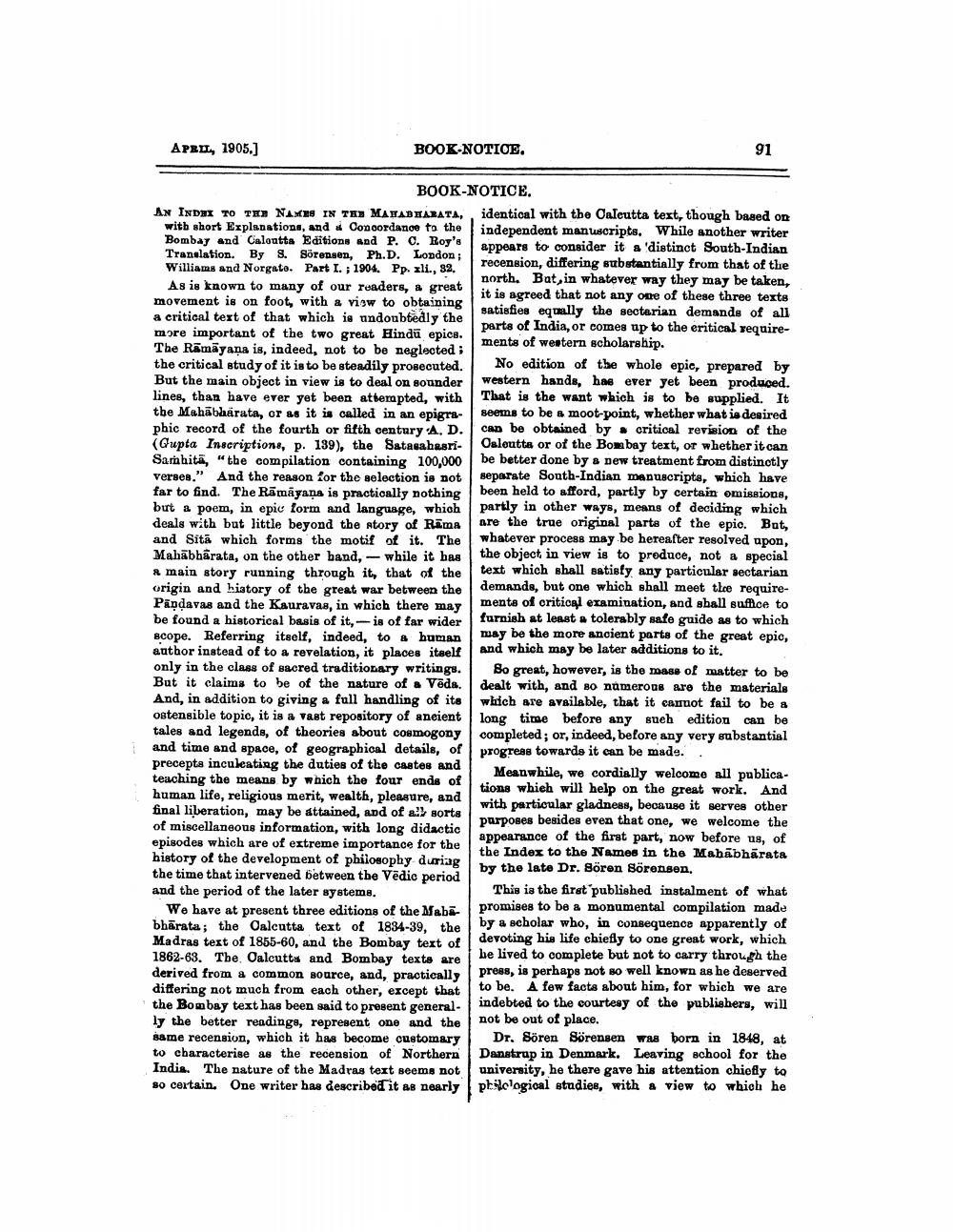________________
APRIL, 1905.]
BOOK-NOTICE.
91
BOOK-NOTICE. AN INDHI TO TA) NAMAS IN TE MATADTARATA, identical with the Calcutta text, though based on with short Explanations, and # Concordance to the indenandent manuscrints. While another writer Bombay and Caloutta Editions and P. C. Roy's Translation.
appears to consider it a 'distinct South Indian By S. Sorensen, Ph.D. London ;
recension, differing substantially from that of the Williams and Norgato. Part I. ; 1904. Pp. xli., 82.
north. Bat, in whatever way they may be taken, As is known to many of our readers, a great
it is agreed that not any one of these three texts movement is on foot, with a view to obtaining
satisfies equally the sectarian demands of all a critical text of that which is undoubtedly the
parts of India, or comes up to the eritical requiremore important of the two great Hindu epics. The Rāmāyaṇa is, indeed, not to be neglected ;
ments of western scholarship. the critical study of it is to be steadily prosecuted.
No edition of the whole epic, prepared by But the main object in view is to deal on sounder
western hands, has ever yet been produced. lines, than have ever yet been attera pted, with
That is the want which is to be supplied. It the Mahābharata, or as it is called in an epigre
seems to be a moot-point, whether what is desired phic record of the fourth or fifth century A. D. can be obtained by critical revision of the (Gupta Inscriptions, p. 139), the Satavahasri- Osleutta or of the Bombay text, or whether it can Samhita, "the compilation containing 100,000
be better done by a new treatment from distinctly verses." And the reason for the selection is not
separate South Indian manuscripts, which have far to find. The Rāmāyana is practically nothing been held to afford, partly by certain omissions, but a poem, in epic form and language, which
partly in other ways, means of deciding which deals with but little beyond the story of Rama
are the true original parts of the epio. But, and Sita which forms the motif of it. The whatever process may be hereafter resolved upon, Mahābharata, on the other hand, while it has
the object in view is to produce, not a special A main story running through it, that of the
text which shall satisfy any particular sectarian origin and history of the great war between the
demands, but one which shall meet the requirePapdavas and the Kauravas, in which there may
menta of critical examination, and shall suffoe to be found a historical basis of it, -ia of far wider
furnish at least a tolerably safe guide as to which scope. Referring itself, indeed, to a human
may be the more ancient parts of the great epic, author instead of to a revelation, it places itself
and which may be later additions to it. only in the class of sacred traditionary writings. So great, however, is the mase of matter to be But it claims to be of the nature of a Vēds. dealt with, and so numerous are the materials And, in addition to giving a full handling of its which are available, that it cannot fail to be a ostensible topic, it is a vast repository of ancient long time before any sueh edition can be tales and legende, of theories about cosmogony completed; or, indeed, before any very substantial and time and space, of geographical details, of progress towards it can be made.. precepta inculcating the duties of the castes and
Meanwhile, we cordially welcome all publicateaching the means by which the four ends of
tions which will help on the great work. And human life, religious merit, wealth, pleasure, and final liberation, may be attained, and of a
with particular gladness, because it serves other sorts
purposes besides even that one, we welcome the of miscellaneous information, with long didactic
appearance of the first part, now before us, of episodes which are of extreme importance for the
the Index to the Names in the Mahabharata history of the development of philosophy duriag the time that intervened between the Vēdio period
by the late Dr. Sören Sörensen, and the period of the later systems.
This is the first published instalment of what We have at present three editions of the Maba-
promises to be a monumental compilation made
promises bhārata; the Calcutta text of 1834-39, the
by a scholar who, in consequence apparently of Madras text of 1855-60, and the Bombay text of
devoting his life chiefly to one great work, which 1862-63. The Oalcutts and Bombay texts are
be lived to complete but not to carry through the derived from a common source, and, practically
prees, is perhaps not so well known as he deserved differing not much from each other, except that
to be. A few facts about him, for which we are the Bombay text has been said to present general.
indebted to the courtesy of the publishers, will ly the better readings, represent one and the not be out of place. same recension, which it has become customary Dr. Sören Sörensen was born in 1848, at to characterise as the recension of Northern Danstrup in Denmark. Leaving school for the India. The nature of the Madras text seems not university, he there gave his attention chiefly to 80 certain. One writer has described it as nearly philological studies, with a view to which he




